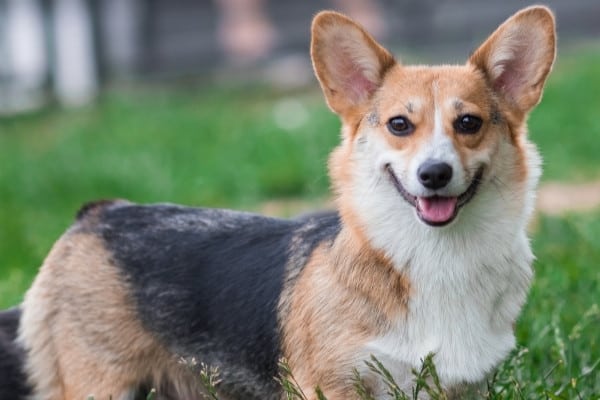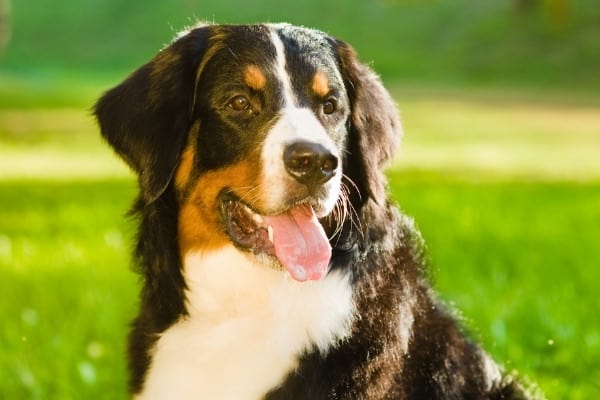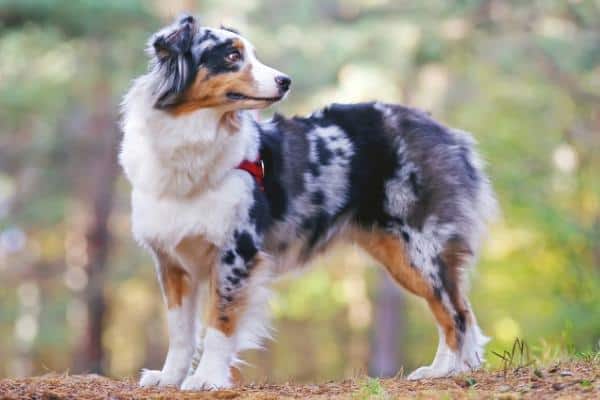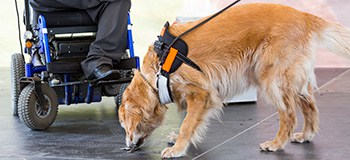
Dogs come in all shapes and sizes. There are different terms that refer to dog coat colors. Calico dogs is a term that is not used often, but it refers to dogs that have coats with three or more colors.
Calico dogs are sometimes called piebald or tricolored. Calico is not a breed of dog but refers to the color, and there are numerous breeds that have this color pattern.
Can dogs be calico? Dogs and any other animals can be calico. The term calico refers to a coat color that consists of three or more colors, though tricolor is the more common term. There are several breeds of dogs that may be considered calico, including Corgis, Beagles, Australian Cattle Dogs, and some Spaniels.
If you are thinking about buying or adopting a pup and want to know more about calico dogs, read on.
The Term Calico as It Relates to Dogs
The term calico is often associated with cats, but dogs can be calico too! Calico dogs are more often called tricolored or piebald.
Most breeders do not refer to their dogs as calico, but these color terms all mean the same.
What Does Calico Mean?
Calico refers to an animal that has a coat that consists of three or more colors. These colors can range from white to black and may come in striped, spotted, or patchy patterns.
What Are Calico Dogs?
Calico dogs have coats of at least three different colors. The term calico refers to the color of a dog and is not a specific breed.
The calico color occurs due to a genetic mutation.
While almost any breed of dog can be calico, this color combination is more common in Corgis, Beagles, Collies, and Spaniels.
Why Are Calico Dogs Expensive?
Some calico dogs are expensive because they are rare. The calico color pattern is caused by a genetic mutation, and it’s not one that is common in certain breeds.
In some breeds, breeders are able to cross-breed specifically for the calico color, but there is no guarantee that the puppies will have the calico coloring.
Some breeders use artificial mutation techniques to achieve the calico color. This can be expensive and causes breeders to charge more for their puppies.
Many people want calico dogs, and the demand and rarity mean breeders can charge higher prices for them.
You can expect to pay between $1,000 to $3,000 for a calico dog, depending, of course, on the breed and pedigree.
What Colors Can Calico Dogs Be?
Calico refers to coats with at least three different colors. In order to be considered calico, dogs do not have to have coats of certain colors, but must have coats with at least three different colors.
Those colors may include:
What Causes the Calico Coloration in Dogs?
Calico dogs’ colors are determined by genetic factors that affect two pigments, eumelanin and pheomelanin. Eumelanin is responsible for dark colors in the coat.
While it typically causes a coat to be black, some genetic mutations can cause pigment variations that can cause the coat to be charcoal, dark brown, or dark gray.
Pheomelanin is the pigment that gives a dog’s coat a brown or golden color.
Variations can cause the brown color to become lighter or darker, making it cream, red, tan, or orange. If dogs lack this pigment, they will have white coats.
There are many genetic mutations that can occur to change the way these pigments color a dog’s coats, which can result in various calico patterns.
Are All Calico Dogs Female?
Both male and female dogs can be calico. Both genders can carry the gene mutations that cause calico fur.
In cats, females are more likely to carry these gene mutations, and while it is possible for male cats to be calico, it’s very rare.
In dogs, the chance of a dog having calico or tri-colored fur is not affected by the dog’s gender.
What Is the Correct Term for Calico Dogs?
While some people do refer to dogs as calico, it’s not a term used by breeders in the industry.
Most breeders and dog owners refer to calico dogs as piebald or tricolored, depending on the pattern.
Correct Terminology for Dog Coat Colors and Patterns
Dog coats come in many different colors and patterns, and many of them have specific names according to the AKC.
It’s a good idea to be familiar with the correct coat terminology if you plan on buying or owning a dog.
Solid
Dogs that are considered solid-colored have one color of fur. There are no spots, stripes, patches, or markings anywhere on the coat.
There are many breeds that are considered solid colored such as Maltese, Golden Retrievers, Irish Setters, Labrador Retrievers, and Bichon Frise.
Parti
Parti is a term that refers to dogs with “particularly” colored fur. Dogs with this coat color have one main color with several other colors present in smaller patches.
The other colors are usually not distributed equally. The gene mutation that creates parti coats is the same one that is responsible for piebald coats.
The piebald mutation interrupts another mutation to give the dog one solid color as well as the various patches of other colors.
Bicolor
Dogs with bicolor coats have two different color combinations that are spread over the dog’s coat. These two colors can vary, and this coat color is sometimes called two-tone.
There are many dogs that are likely to be bicolor, including Rottweilers, German Shepherds, and Pit bulls.
Tricolor
Tricolor refers to any coat with three or more colors. While the term calico isn’t usually used to refer to dogs, tricolored dogs are considered calico.
The colors can be spaced out evenly or may occur in patches of different sizes. The colors can also appear as patterns.
Any breed of dog can be tricolored. Some common breeds that exhibit this coat color include Beagles, Corgis, Collies, Australian Shepherds, and Spaniels.
Merle
Merle is a coat color that consists of one overall pattern with another diluted color on top. In some cases, this can appear as more than one diluted color.
This coloring may occur all over the coat or in patches.
Brindle
Brindle is a color that looks similar to stripes. There is one overall color which is usually lighter and a dark color that covers it in a striped pattern.
When the darker color is the base color and the stripes are lighter, the coat is called reverse brindle.
Ticking
Ticking is a color pattern that occurs on white dogs. The overall coat of the dog should be white, or it should have white patches.
Ticking occurs when flecks of another color appear in the white areas. The ticking colors can vary but are usually darker.
Dogs that do not display white coats can still have the ticking gene mutation, but the ticking will not show up on other fun colors.
Piebald
Piebald coats are mostly white but have patches of other colors mixed in. In many cases, there are several different colors present on the coat.
Piebald dogs can also be referred to as calico dogs, but this term is not as widely used by breeders or owners.
Harlequin
This is a color that refers to a coat that is mostly white but has black, blue, or gray patches. The patches are usually large but can be small.
Great Danes are one of the most common breeds to have this coat color.
Sable
Sable is a coat color that occurs when each piece of fur is light at the base but has a darker color at the tip. Dogs with sable coats usually have black facial masks as well.
Common Tri-Colored Breeds

While many dog breeds can be tricolored, some are more likely to have this coat color than others.
This may be due to natural genetic mutations or deliberate cross-breeding to make the mutation more common in these breeds.
Here are some of the most common tricolored dog breeds:
- Boxers
- Chihuahua
- Beagle
- Pomeranian
- English Bulldog
- Bernese Mountain Dog
- Smooth Collie
- Rough Collie
- Border Collie
- Basset Hound
- Bull Terrier
- Australian Cattle Dog
- Pembroke Corgi
- Papillion
- Cavalier King Charles Spaniel
Conclusion for Calico Dogs
Dogs have coats that come in many different colors and patterns. Calico is one of these patterns.
Although the term calico is not used by many breeders or owners, it is a well-known color within the dog world.
Calico dogs are beautiful, and many different breeds can have this coat color. If you love the tricolored look of calico dogs, you may want to make one part of your family.





